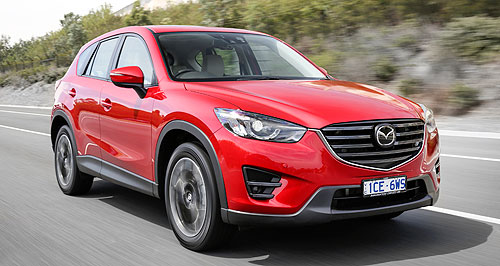Future models - Mazda - CX-5Mazda CX-9 shapes next-gen CX-5Quiet ride: Mazda engineers worked hard to reduce the NVH levels in the new CX-9 (left) and the improvements are likely to carry over to the next CX-5. Reduced noise measures and likely 2.5L turbo in pipeline for next-gen Mazda CX-512 Jul 2016 MAZDA is set to introduce noise reduction measures such as a thicker floorpan from the latest CX-9 seven-seat SUV to the second-generation CX-5 due in less than two years, while the 2.5-litre turbo-petrol engine is also under consideration for the next mid-sizer. While not expected to grow in size, the second-gen version of Australia’s best-selling mid-size SUV could get a performance and economy lift, with the new CX-9’s 2.5-litre four-cylinder a chance for higher-end versions, given both models share the same basic platform and running gear. While the Japanese car-maker would not confirm a turbo-petrol unit for the next CX-5, Mazda North America vehicle development engineer Dave Coleman hinted that many variations are possible due to the modularity of the SkyActiv platform and powertrains. “Of course, the CX-9 learnings will be implemented in future Mazdas like the CX-5,” he told GoAuto at the launch of the latest CX-9 in Melbourne last week. “The SkyActiv technology can be shared across models.” Mazda’s attempts to address noise, vibration and harshness (NVH) issues in all of the so-called Generation Six vehicles launched under the SkyActiv banner with the CX-5 back in 2012 has come about following feedback from both the press and customers, with the CX-9 providing the first opportunity for the company to take action. To that end, road noise in the CX-9 has been cut significantly through a thicker floorpan, additional sound-deadening insulation (from 7.5kg to 24kg’s worth), improved aerodynamics, better sealing properties, smaller panel gaps, and thicker windscreen and side-window glass. According to Mr Coleman, Mazda’s much-touted ‘gram-by-gram’ weight reduction philosophy has allowed some weight to be added in a tailored manner to palpably improve the vehicle. “In the case of the second-generation CX-9, we generally tried to lose 100kg, but in some versions it is up to 162kg lighter,” he said. “So the big kilogram drop overall allowed us to use heavier sound-deadening material and that has made a huge difference.” Finally, like the new CX-9, which is shorter than the original from 2007, the next-generation CX-5 will most probably maintain the current version’s dimensions, since the company believes it offers exactly the right size for the medium SUV segment. The preceding vehicle – the CX-7 of 2006 – sold below targets because it fell between two stools in terms of size. “Before the CX-5 we had the CX-7, and that was developed for US tastes, but it failed because it was seen as too big for Europe and Australia and too small for Americans,” Mazda North America vice-president of research and development Masashi Otsuka told GoAuto. “The CX-5 is now in the sweet spot. If it grows, some markets will complain.” Mr Otsuka added that Mazda listens to what buyers want in order to deliver the best possible vehicle it can. “We are an OEM (Original Equipment Manufacturer) car-maker, and so we need to earn money,” he said. “So our philosophy is for customers to stay happy, so we move to continue improving our product.”  Read more11th of July 2016  Mazda CX-9 engineers ‘stalked’ SUV ownersWith permission of course, as Mazda gained data observing real-world usage patterns11th of July 2016  Mazda CX-9 designed from the inside outOwners of the current Mazda CX-9 studied and interviewed to improve the breed8th of July 2016  Driven: Mazda CX-9 sales set to doubleHigher spec, lower pricing, slashed thirst to drive Mazda CX-9 demand4th of March 2016  Mazda slashes CX-9 fuel consumptionFuel use cut by as much as a quarter for new Mazda CX-9CX-5 pricing
Motor industry news |
Click to shareMazda modelsResearch Mazda CX-5 pricing
Motor industry news |
















Facebook Twitter Instagram